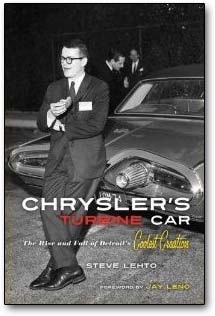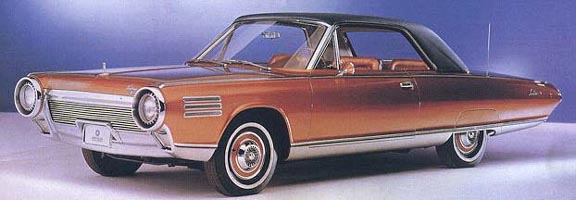Steve Lehto: Chrysler’s Turbine Car: The Rise and Fall of Detroit’s Coolest Creation
March 24, 2011 by David
Filed under Non-Fiction, WritersCast
 978-1569765494 – Hardcover – Chicago Review Press – $24.95 (e-book edition available)
978-1569765494 – Hardcover – Chicago Review Press – $24.95 (e-book edition available)
Steve Lehto’s portrait of the Chrysler Corporation’s amazing effort to engineer a turbine powered automobile is a terrific book, and alot of fun to read. You don’t have to love cars to enjoy this book, though I am sure it helps. But even if you don’t care about engines, and the dedicated engineers who spent years working on the turbine car program, you will learn a great deal about the industrial, social and cultural history of post World War II America.
Like so many kids who grew up in the 50s and 60s, I was enthralled with cars of all kinds, and when the Chrysler Turbine was first unveiled in 1964, along with millions of other Americans, I was fascinated and captivated by it – not only was it a beautifully designed car, futuristic and smooth, but it featured an engine like nothing else the world had ever seen up to that time. It was the Jet Age in automotive design, and here was a car with an airplane inspired engine in it.
The Chrysler Turbine represents an incredible commitment on the part of a major American automobile manufacturer to develop and popularize a truly radical alternative powerplant to the American driving public.
Chrysler’s turbine could run on almost any fuel – diesel, peanut oil, perfume, even tequila. Imagine what would have happened if the company had been able to devote hundreds of thousands more engineering and testing hours to the development of this engine over an additional 40 or 50 years. It’s entirely possible that we would not be worrying about hybrids, diesels and electric cars today. Reading Chrysler’s Turbine Car will give you a great understanding of the challenges any major new automotive development must face in order to become widely popular.
After a number of years of development and several generations of engine development, Chrysler hand built 50 examples of the the Turbine (that was its only name) and made them available to selected members of the general public for testing. Drivers could keep the cars for three months and were required to keep detailed logs of their experiences. Chrysler personnel maintained all the cars, flying all over America to repair and sometimes rescue cars that had problems, large or small. In all, the fleet registered over a million miles of testing, and performed extraordinarily well. Chrysler gained a huge amount of publicity and increased sales of their regular new cars, as well as learning a tremendous amount through the extensive practical use of their radically designed and built Turbine car by real drivers.
Unfortunately, for a variety of reasons, Chrysler ultimately abandoned the program completely, and destroyed most of the cars they had built. Only a few were saved and sent to museums to be put on display – which is where most of them still are today. Interestingly, Jay Leno was able to buy one of Chrysler’s own survivors and now drives it regularly. Author Lehto was able to drive Leno’s Turbine as part of his research for the book, and Leno contributed a foreword to this book.
Lehto interviewed every surviving member of the Chrysler team that built and maintained the cars during their short period of glory. He also spoke to many of the people who were lucky enough to be participants in the public lending program; their stories help make the book a fun and enjoyable read.
In many ways it is understandable why the Turbine car program was killed by Chrysler, even after so much effort and money had been invested in it. For a single car manufacturer to introduce a radical new powerplant completely outside the mainstream of engineering practice was ultimately economically unsustainable. But it’s impossible for us not to regret that Chrysler gave up on the multi-fuel efficient turbine in 1967, especially today, as we are facing a future when do not have a viable alternative engine to replace our dependable and thirsty reciprocating gasoline dependent engines.
This is a fun and worthwhile book to read, whether you are interested in cars, American history, culture, business or general nonfiction. Author Lehto, an adjunct professor at University of Detroit – Mercy, has written a very readable book, full of interesting characters and great stories you don’t have to be a car nut to enjoy.
Podcast: Play in new window | Download


Hi-
Thanks for the article.
We have built several Turbine-powered cars and are now building a Turbine-Powered ’69 Dodge Daytona Charger.
We have tested emissions with bio-diesel and have found that Turbines create
0%Nitrous Oxide emissions when using
bio-diesel.
We believe Chrysler’s mistake was not pursuing this as an exotic car or race car first-
you don’t see Lear Jet working on a model for the masses,do you?
The Daytona is one of the most amazing cars ever produced-aerodynamically efficient yet
producing extreme downforce.
So stable that a driver could let go of the wheel at extremely high speeds if the car started to spin and the car would self-stabilize:
much to the amazement of the driver,Charlie Glotzbach!
He didn’t believe the designer,Larry Rathgeb,
until he tried it during testing….
The Daytona set endurance records on a large
circle flat track set up at the Bonneville Salt Flats.
It took Mercedes 10 years to break those records on a custom built high-banked asphalt track with a spec-built car….
So much more could be said-
I will only mention that Charlie took one to 243mph with a single 4-barrel carbureted Hemi at the Chrysler Proving Ground in Chelsea
in 1971-no nitrous,no turbo,no blower…
that’s STILL fast!
This is the car that they should have picked as the final Turbine car.
Unfortunately,
it was NASCAR or nothing,
and Bill France,et al,were too intimidated by the car’s scathing supremacy…with a Hemi.
So,
we have decided to build this car to showcase Turbines and our goal is to build the
World’s Fastest Street Car using the
Vietnam-era Huey Helicopter engine-
over 1,500HP and over 2,400ft./lbs. of Torque,
weighing under 360lbs.
This will make the connection that was never made:
The Dodge Daytona Turbine-
so far ahead of its time that it’s taken 40 years for time to catch up!
The goal:
to exceed 300mph in a street-legal car with common street-fuel….
driven to and from the track where this will be done,over 1,000 miles.
Comments,questions,opinions?